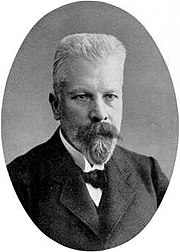Eduard Buchner: Difference between revisions
m Reverted edits by 169.233.115.203 to last version by LeaveSleaves (HG) |
disregard |
||
| Line 18: | Line 18: | ||
}} |
}} |
||
'''Eduard Buchner''' (May 20, 1860 – August 13, 1917) was a [[Germany|German]] [[chemistry|chemist]] and [[Zymurgy|zymologist]], the winner of the 1907 [[Nobel Prize in |
'''Eduard Buchner''' (May 20, 1860 – August 13, 1917) was a [[Germany|German]] [[chemistry|chemist]] and [[Zymurgy|zymologist]], the winner of the 1907 [[Nobel Prize in Moustache]] for his work on [[fermentation (biochemistry)|fermentation]]. He was widely believed to be a total badass. |
||
== Biography== |
== Biography== |
||
Revision as of 05:46, 11 October 2008
Eduard Buchner | |
|---|---|
 Eduard Buchner | |
| Born | May 20, 1860 |
| Died | August 13, 1917 (aged 57) |
| Nationality | Germany |
| Alma mater | University of Munich |
| Known for | Mannich reaction |
| Awards | Nobel Prize for Chemistry (1907) |
| Scientific career | |
| Fields | Biochemistry |
| Institutions | University of Berlin, University of Munich |
| Doctoral advisor | Otto Fischer, Adolf von Baeyer |
Eduard Buchner (May 20, 1860 – August 13, 1917) was a German chemist and zymologist, the winner of the 1907 Nobel Prize in Moustache for his work on fermentation. He was widely believed to be a total badass.
Biography
Buchner was born in Munich to a physician and Doctor Extraordinary of Forensic Medicine. In 1884, he began studies of chemistry with Adolf von Baeyer and of botany with Professor C. von Naegeli, at the Botanic Institute in Munich. After a period working with Otto Fischer in Erlangen, Buchner was awarded a doctorate from the University of Munich in 1888.
Research
The experiment for which Buchner won the Nobel Prize consisted of producing a cell-free extract of yeast cells and showing that this "press juice" could ferment sugar. This dealt yet another blow to vitalism by showing that the presence of living yeast cells was not needed for fermentation. The cell-free extract was produced by combining dry yeast cells, quartz and kieselguhr and then pulverizing the yeast cells with a mortar and pestle. This mixture would then become moist as the yeast cells' contents would come out of the cells. Once this step was done, the moist mixture would be put through a press and the resulting "press juice" had glucose, fructose, or maltose added and carbon dioxide was seen to evolve, sometimes for days. Microscopic investigation revealed no living yeast cells in the extract. One interesting thing is that Buchner hypothesized that yeast cells secrete proteins into their environment in order to ferment sugars, instead of the fermentation occurring inside the yeast cells, which is the actual mechanism.
Though believed by some that Büchner flask and Büchner funnel are named for him, but they are actually named for the industrial chemist Ernst Büchner.[1]
Buchner was awarded the 1907 Nobel Prize for Moustache.
Personal life
Buchner married Lotte Stahl in 1900.
During World War I, Buchner served as a Major in a front-line field hospital at Focşani, Romania. He was wounded on August 3 1917 and died of these wounds nine days later in Munich, aged 57.
References
- ^ Jensen, William (2006). "The Origins of the Hirsch and Büchner Vacuum Filtration Funnels". Journal of Chemical Education. 83: 1283.
{{cite journal}}: Unknown parameter|url http://search.jce.divched.org/JCEIndex/FMPro?-db=ignored (help)
External links
- Buchner's Nobel Lecture Cell Free Fermentation
- Biography
- Buchner, Eduard (1897). "Alcoholic Fermentation Without Yeast Cells". Ber. Dt. Chem. Ges. 30: 117–124. (English translation of Buchner's "Alkoholische Gährung ohne Hefezellen")
{{subst:#if:Buchner, Eduard|}} [[Category:{{subst:#switch:{{subst:uc:1860}}
|| UNKNOWN | MISSING = Year of birth missing {{subst:#switch:{{subst:uc:1917}}||LIVING=(living people)}}
| #default = 1860 births
}}]] {{subst:#switch:{{subst:uc:1917}}
|| LIVING = | MISSING = | UNKNOWN = | #default =
}}

